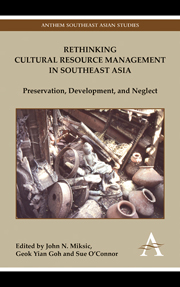Book contents
Chapter 13 - Singapore's Archaeological Heritage: What Has Been Saved
from Singapore
Published online by Cambridge University Press: 05 May 2012
Summary
Introduction
I first became involved with Singapore's heritage in January 1984. At that time I was a Ford Foundation–sponsored project specialist in archaeology assigned to Gadjah Mada University in Yogyakarta, central Java, Indonesia. I was invited by the Singapore National Museum to conduct a short test excavation at a site which it was suspected might still preserve artifacts representing the precolonial occupation of this island. The project succeeded in uncovering evidence of an important trading settlement dating back to the fourteenth century (Miksic 1985, 2006; Miksic and Low 2004).
In 1987 I was invited back to Singapore to teach ancient Southeast Asian history at the National University of Singapore and to provide consultancy services to the Parks and Recreation Department which was in charge of developing the historical and archaeological resources of the park in which the archaeological site was discovered in 1984. Since 1987, I have been involved in projects which have grown out of the Singapore government's desire to develop Fort Canning Hill into a historical park. My duties have largely revolved around various research projects aimed at accumulating and organizing evidence which could be put to use in various forms of outdoor displays. My intention in this chapter is to show how research and development planning at Fort Canning have related to each other.
Archaeology is a small part of the larger sphere of conservation activity in Singapore.
- Type
- Chapter
- Information
- Rethinking Cultural Resource Management in Southeast AsiaPreservation, Development, and Neglect, pp. 217 - 232Publisher: Anthem PressPrint publication year: 2011



